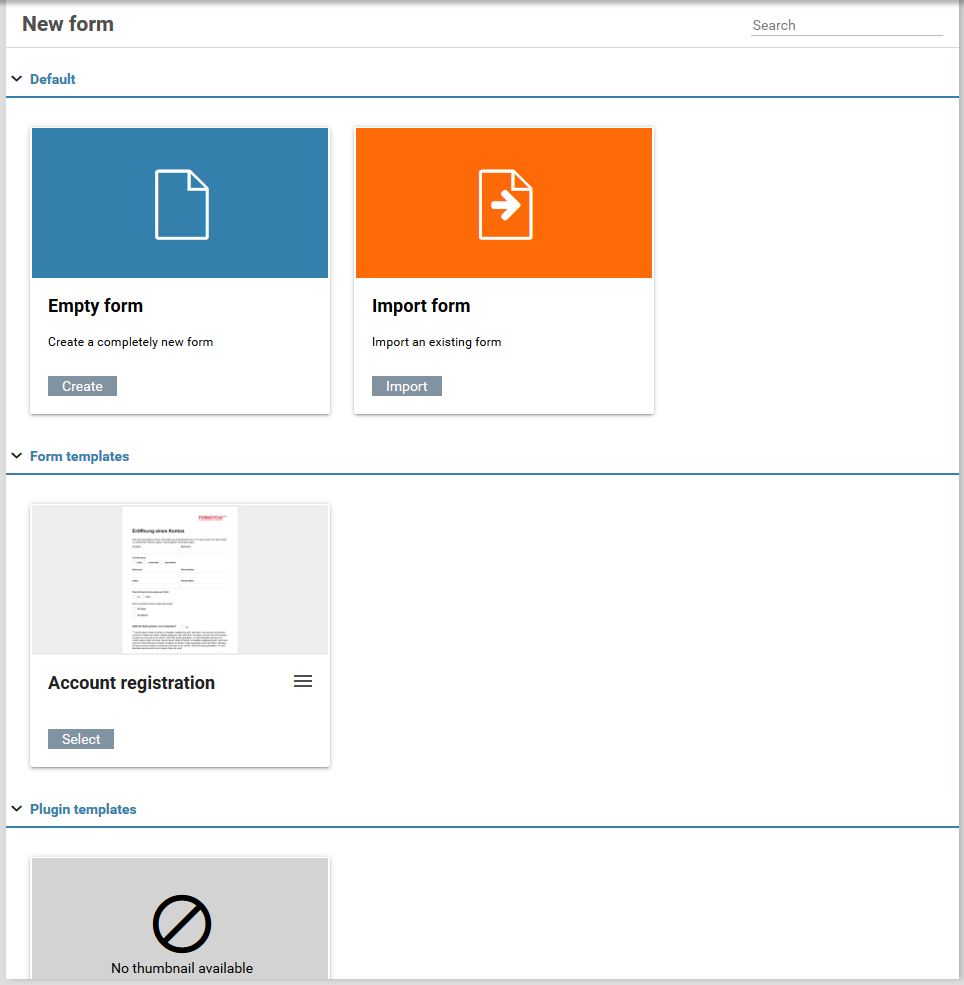Creating forms
The button Create new form on the Startseite or on the form overview page opens the selection for creating forms (see figure). There are serveral ways of creating new forms:
- Empty form
- Creates a completely empty form and opens the Xima® Formcycle Designer for editing.
- Import form
- Opens a selection dialog through which previously exported forms can be imported. See form import.
- Using form templates
- Via the form menu aleready existing forms can be saved as templates. These templates may be used as a quick start for form creation. The Setting of the form template will be preserved. This includes the form files, the workflow processing, double opt-in, inbox and data table settings.
- Using plugin templates
- Form templates (with workflow processing) can also be created with plugins. If plugin templates are activated, they will show up here.
Form import
There are two different mechanisms for importing forms. Which import mechanism is being started depends on the Xima® Formcycle version that has exported the form.
Form exports from Xima® Formcycle below version 6.2
After selecting the form file the form will be imported. Xima® Formcycle tries to resolve possible dependencies to files & templates, inboxes, data sources, etc. during import. If no matiching element is found, then the dependency can not be resolved.
6.2.0+ Form exports from Xima® Formcycle since version 6.2
The import of forms since Xima® Formcycle version 6.2 allows to update or create existing or missing form dependencies. This means that used files & templates, inboxes, data sources, etc. can be updated or created during import. Xima® Formcycle tries to automate this process as much as possible so that already existing and unchanged dependencies will be resolved automatically. If a dependency could not be resolved automatically then user has to decide how the dependency should be resolved (see figgure). After the form import all non-resolved dependencies will be listed in a dialog (see figgure).
Wann ist eine Nutzerinteraktion erforderlich?
Eine Nutzerinteraktion ist erforderlich, wenn eine Formularabhängigkeit noch nicht im Mandanten exisitiert oder die Abhängigkeit bereits existiert, aber nicht identisch mit der Abhängigkteit im Formularexport ist. Eine Nutzerinterkation ist z.B. erforderlich, wenn in der Formularverarbeitung eine Mandant-Datei (z.B. PDF) verwendet wird, welche bereits existiert aber einen anderen Inhalt besitzt.
Wie können Abhängigkeiten aufgelöst werden?
- Überschreiben
- Exisitiert das Element bereits im System, so kann es überschrieben werden. Diese Option steht nicht für Postfächer oder Benutzergruppen zur Verfügung.
- Anlegen
- Das Elemente wird im System angelegt. Wenn nötig, wird der Name des Elements angepasst.
- Alternative verwenden
- Diese Option exisitiert nur für Benutzergruppen und Postfächer. Anstatt das Element neu anzulegen, kann einen bereits exisitierende Alternative verwendet werden.
- Ignorieren
- Die Formularabhängigkeit wird ignoriert. Dies kann zu Fehlern in der Darstellung oder Verarbeitung des Formulars führen.

